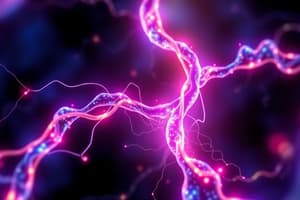Podcast
Questions and Answers
Which structure is the secretory region of the neuron?
Which structure is the secretory region of the neuron?
axon terminal
In axonal transport, anterograde movement is transport away from the cell body. Which of the following move in this direction?
In axonal transport, anterograde movement is transport away from the cell body. Which of the following move in this direction?
- Nucleus
- Enzymes for neurotransmitter synthesis (correct)
- Worn out organelles
- Mitochondria (correct)
Which of the following does not describe the function of the structure labeled (B)?
Which of the following does not describe the function of the structure labeled (B)?
Conductive region of the neuron
Identify the correctly classified neurons.
Identify the correctly classified neurons.
Which of the following terms is correctly matched with its definition?
Which of the following terms is correctly matched with its definition?
If we consider neurons to be carrying on conversations, which portion of the neuron 'speaks' by releasing neurotransmitters?
If we consider neurons to be carrying on conversations, which portion of the neuron 'speaks' by releasing neurotransmitters?
Which letter matches the process(es) of the neuron that provide(s) an enormous surface area for receiving signals from other neurons?
Which letter matches the process(es) of the neuron that provide(s) an enormous surface area for receiving signals from other neurons?
Indicate, by letter, where one would find short-distance signals called graded potentials that travel toward the cell body.
Indicate, by letter, where one would find short-distance signals called graded potentials that travel toward the cell body.
Interneurons and motor neurons are which of the following?
Interneurons and motor neurons are which of the following?
A neuron with a distal peripheral process and a central process that extends to the CNS is most likely _________________.
A neuron with a distal peripheral process and a central process that extends to the CNS is most likely _________________.
In axonal transport, retrograde movement is transport toward the cell body. Which of the following move in this direction?
In axonal transport, retrograde movement is transport toward the cell body. Which of the following move in this direction?
Which of the following is not a characteristic of neurons?
Which of the following is not a characteristic of neurons?
Which of the following is not true of motor (efferent) neurons?
Which of the following is not true of motor (efferent) neurons?
What is the difference between nerves and tracts?
What is the difference between nerves and tracts?
Which of the following characteristics is not associated with a myelinated nerve fiber in the peripheral nervous system?
Which of the following characteristics is not associated with a myelinated nerve fiber in the peripheral nervous system?
In considering the types of neurons and their predominant functions, efferent is to multipolar as __________.
In considering the types of neurons and their predominant functions, efferent is to multipolar as __________.
Which type of axonal transport allows certain viruses to circumvent the barrier created by astrocytes to enter into the CNS?
Which type of axonal transport allows certain viruses to circumvent the barrier created by astrocytes to enter into the CNS?
The chromatophilic substance, or Nissl bodies, seen in the neuron cell body represents which cellular organelle(s)?
The chromatophilic substance, or Nissl bodies, seen in the neuron cell body represents which cellular organelle(s)?
Organelles for degradation or recycling are moved through the axon by __________.
Organelles for degradation or recycling are moved through the axon by __________.
If we consider neurons to be carrying on conversations, which portion(s) of the neuron 'listen(s)?'
If we consider neurons to be carrying on conversations, which portion(s) of the neuron 'listen(s)?'
Neurons can be classified structurally by the number of processes extending from their cell bodies. Which of the following is the most common neuron type in humans?
Neurons can be classified structurally by the number of processes extending from their cell bodies. Which of the following is the most common neuron type in humans?
From where can collaterals emerge on a myelinated nerve?
From where can collaterals emerge on a myelinated nerve?
Flashcards are hidden until you start studying
Study Notes
Neuron Structure and Function
- The axon terminal is the secretory region of the neuron, responsible for releasing neurotransmitters.
- Mitochondria and enzymes used for neurotransmitter synthesis move anterograde, transporting materials away from the cell body.
- The conductive region of a neuron does not describe the axon terminal.
- Most interneurons are classified as multipolar neurons and remain restricted to the central nervous system (CNS).
- In the CNS, a nucleus refers to a collection of neuron cell bodies.
Neuron Communication
- The axon terminal functions as the communication point by releasing neurotransmitters, likened to the "speaking" part of a conversation.
- Dendrites serve as the receiving end of signals, providing extensive surface area for other neurons to connect.
- Graded potentials, which are short-distance signals, travel toward the cell body primarily through dendrites.
Neuron Types and Classifications
- Both interneurons and motor neurons fall under the category of multipolar neurons.
- A sensory neuron is characterized by having a distal peripheral process and a central process that extends into the CNS.
- Retrograde movement involves transport back toward the cell body, such as for worn-out organelles.
- Neurons are not small, simple-structured cells; they have complex features and functions.
- Efferent (motor) neurons are not classified as bipolar; they are typically multipolar.
Tracts vs. Nerves
- In the CNS, bundles of axons are called tracts, while in the peripheral nervous system (PNS), they are referred to as nerves.
Myelination and Signal Conduction
- Myelinated nerve fibers in the PNS are characterized by fast conduction of nerve impulses.
- The most common type of neuron in humans is multipolar, classified by the number of processes extending from their cell bodies.
- Collaterals can emerge at the myelin sheath gaps (nodes of Ranvier) on a myelinated nerve.
Cellular Components and Transport Mechanisms
- The chromatophilic substance or Nissl bodies in neuron cell bodies consist of rough endoplasmic reticulum.
- Retrograde movement is responsible for transporting organelles destined for degradation or recycling back to the cell body.
- Retrograde transport allows certain viruses to bypass barriers set by astrocytes, enabling them to enter the CNS.
Listening and Engaging Neuron Parts
- In conversational terms, dendrites and the cell body act as the "listeners" in neuron communication.
Studying That Suits You
Use AI to generate personalized quizzes and flashcards to suit your learning preferences.




